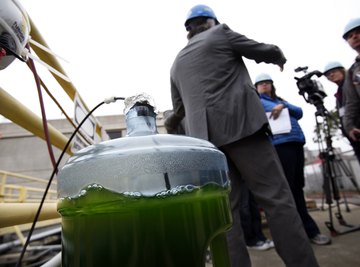
Algae are microscopic, plant-like, single-celled organisms -- sometimes forming colonies of seaweed -- that can be used to make biofuel, which is fuel derived from living things. While industrial processes are under development for large-scale biofuel production, a then-16-year-old student, Evie Sobczak, won the 2013 Intel International Science and Engineering Fair for her garage-based process of turning algae into biofuel. Making biofuel from algae involves cultivating and harvesting the algae, extracting the raw oil and then refining it.
Cultivating Algae
Using materials from your local home improvement store, you can build a cultivation chamber in a machine shop. The chamber is a box containing a solution of algae into which you introduce red-orange colors of light via PVC pipes -- this light produces the largest yield of algae. Install an aquarium bubbler and electric paddles to create and agitate air bubbles. The algae absorbs bubble-borne carbon dioxide, which they use to generate energy via photosynthesis. Protect against acidic buildup by adding a base, sodium carbonate.
Harvesting Algae
After 12 weeks, combine iron powder with the algae to form a ferric-oxide polymer that precipitates to the bottom of the chamber. After draining the excess water, which you can recycle to grow more algae, use a strong magnet to remove any uncombined iron powder and collect the biomass for extraction.
Extracting Raw Oils
Use a a high-pressure, high-salt system to shoot the algae slurry into a chamber bathed in sound waves from a 1-watt ultrasonic generator and augmented by small horns. These waves disrupt the algae cell walls, freeing the internal contents for collection in a beaker. Bathe the collected material in distilled water. A lipid, or oily, layer forms on top of the water. Skim this layer with a pipette to collect the lipids.
Refining the Biofuel
Using a process called transesterification, mix barium hydroxide with the algal lipids in the presence of methanol. The barium acts as a catalyst that, over a three-hour period, causes the methanol to react with the lipids to form biofuel. Next, violently mix the materials. Finally, wash away the algae residue with distilled water. When Evie Sobczak tested the biofuel resulting from this process, she found that it burned more efficiently than No. 2 diesel. She also claimed that the biofuel would give better vehicle mileage than would diesel fuel.
References
About the Author
Based in Greenville SC, Eric Bank has been writing business-related articles since 1985. He holds an M.B.A. from New York University and an M.S. in finance from DePaul University. You can see samples of his work at ericbank.com.
Photo Credits
Sarah Rice/Getty Images News/Getty Images
